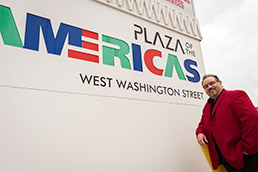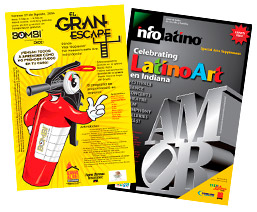Subscriber Benefit
As a subscriber you can listen to articles at work, in the car, or while you work out. Subscribe NowThirty-odd years ago, Carlos Sosa was attending the University of Cincinnati when someone asked what he’d like to eat.
The well-meaning person assumed Sosa wanted tacos.
 Graphic designer Carlos Sosa’s work ranges from public signs to private consulting. (IBJ photo/Eric Learned)
Graphic designer Carlos Sosa’s work ranges from public signs to private consulting. (IBJ photo/Eric Learned)Thing is that Sosa grew up not in Mexico (as if that were justification for assuming he wanted tacos) but in a Puerto Rican/Jewish/Italian neighborhood in the South Bronx. If one were making assumptions about what he’d like to eat, a Puerto Rican dish such as carne guisada (stewed beef) would have been a better guess.
All these years later, Latinos are no longer a novelty in the corn belt, but misperceptions remain. Businesses trying to endear their brands to this growing population—nearly 10 percent of Indianapolis residents—can’t afford to make such cultural blunders as Latino influence on society grows.
 Sosa Group advertising aims for a culturally appropriate message, not just translation to Spanish. (Illustrations courtesy of Sosa Group)
Sosa Group advertising aims for a culturally appropriate message, not just translation to Spanish. (Illustrations courtesy of Sosa Group)“There’s a strong likelihood you have more salsa in your refrigerator than ketchup,” said Sosa, 50, president and CEO of Indianapolis design and marketing firm Sosa Group.
Sosa’s recognizable work includes the logos for IndyGo and the Indianapolis Indians baseball team.
 But much of what Sosa does these days is out of the public eye. He’s counseled numerous marketers and community organizations on how to most effectively reach the growing Latino population.
But much of what Sosa does these days is out of the public eye. He’s counseled numerous marketers and community organizations on how to most effectively reach the growing Latino population.
A Hoosier business owner might think it’s just a matter of hiring a translator to draft ad copy in Español and, voila! … er, aqui’!
Sosa will tell you it’s not a matter of language only, however.
Even within the broader Latino community, “to have an impact, the message needs to fit the cultural context and the mind-set of the targeted audience,” he tells clients.
One example of the cultural differences is the type of bean favored in various countries. Hispanics happen to eat more beans than do non-Hispanics, but that’s not the end of the story. Mexicans tend to prefer refried brown beans while Puerto Ricans more often than not cook with gandules, which are a greenish-brown pigeon pea.
Oh, and Dominicans often prefer red beans while Cuban dishes tend to use black beans.
 “For those who sell beans, knowledge of this breakdown could be the key to their successful marketing program,” Sosa said.
“For those who sell beans, knowledge of this breakdown could be the key to their successful marketing program,” Sosa said.
Yet, if you’re trying to reach a general Latino audience, “you have to understand how to be as common as possible.”
Fluent strategy
It also helps to have employees who can speak the language.
That doesn’t mean hiring local college kids who are studying Spanish, as a local bank did years ago at one of its west-side suburban branches.
It was a good start, but ideally the employees are native speakers, or at least fluent. And they’ll engender more trust if they know a thing or two about the culture.
One bank Sosa worked with that made progress—Union Federal, which is now owned by Huntington Bank—produced extensive Spanish-language marketing materials for its bank lobbies and added employees who could speak the language. That “ingratiated Union Federal in the [Latino] community.”
The momentum grew such that, at one point, large groups of Latino men would enter a west-side branch together to make deposits, which at first was a bit startling for bank employees. Those big groups weren’t a threat but rather were more reflective of a cultural bent toward supporting one another, in this case in learning how to use the banking system.
It’s one reason part of Sosa’s work with corporate Indiana includes encouraging firms to provide their employees with cultural training.
He tells businesses they also would do well to identify specific demographics within the Indianapolis Latino communities that are relevant to the company’s marketing strategy.
And that marketing might be nontraditional. Family-focused events at a store or door-to-door outreach or even an ad in a church bulletin are among them.
Sosa’s expertise in design wasn’t the only reason Richard Miller, founder and president of Fineline Printing Group, hired him to do a rebranding a few years ago.
“I chose him because he does have a feel for the Hispanic and Latino” community, said Miller, who is from Argentina.
Connecting Latinos
“Frankly,” said Sosa, “Latinos are learning about each other.”
In that vein, Sosa last September launched a website—IndyLatino.com—to better connect the Latino community and the broader population.
The site is a sort of meeting place and includes information about jobs, Latino-related news and entertainment.
The site also seeks to accommodate the English-speaking children of Latino parents who moved here. A number of businesses, such as Indianapolis-based RCI, have ads on the site with links to job openings.
One common trait of companies that are successful in multicultural marketing is knowing where people get their information, said Kim Saxton, an associate professor of marketing at Indiana University.
Big companies such as State Farm Insurance have been particularly good at this, she said. The insurer sponsors shows, such as the Billboard Mexican Music Awards, on Spanish-language networks. It has also sponsored reality shows on Telemundo about Latinos who are trying to acclimate to life in the United States. It’s made numerous gifts to Latino-related philanthropic organizations.
Almost one-fourth of the insurer’s agents have Spanish-speaking personnel, and many of them visit community events, such as soccer games, as part of their community outreach.
These are the sorts of things Sosa has been advising Indiana businesses to do over the years. His one-man shop—though his network of expertise consists of about a half-dozen people in various fields, including experts in translation and marketing—juggles about a dozen clients each year. Many of them are small, but have included giants such as Simon Property Group and St. Vincent Health.
One of his new contracts is helping the IndyConnect transit initiative get the word out to the Latino population about the potential for expanding bus and rail transit.•
Please enable JavaScript to view this content.
